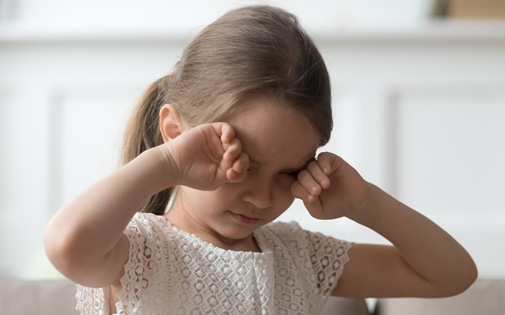
Strabismus is known as cross-eye that is the deterioration of both eyes among people. Both eyes cannot look at the same target constantly. And generally, one eye can fix itself to an object while the other eye slips to a different side. While one eye looks forward, the other eye can look in different directions (outward, down, up). In some cases, both eyes occur strabismus, too.
There are 6 muscles that provide to moving our eyes. These muscles are controlled by the nerve fibers that belong to these muscles in the brain. The eyes want to look in which direction, a remark is sent by the brain to the related muscle for looking in that direction and it is provided to muscles working and looking to the target area.
Strabismus has occurred, if there is a defect between the eye muscles that control the eye movements and the nerve impulses in the brain that manages them, or if some of the muscles work too much over or less over, or if there is visual impairment. As a classic declaration, the eyes which don’t see are slightly crossed. Because we move our eyes towards the direction that want to look at the object, and therefore we need to be able to see the object and need to be able to focus on the object. This is the most important rule, for stimulating the muscles.
The eye moves act reflexively in different directions and therefore it seems slipped that looked from the outside because the eye can not focus when it is not see anything. Also, even the eyes seeing clearly, if one muscle can not work with the required power, muscular contraction can not provide and so it can not function. Plus, if the nerve plexus that send stimulation to the eyes have a defect, cross-eye occurs.
Infection during the pregnant period occurred inflammatory disease in a childhood period, some traumas had lived in the past and had lazy or crossed-eye some family members which the factors can be causes of strabismus.
Cross-eye situations can be permanent or temporary depending on strabismus’s cause. Unreal strabismus can be seen in babyhood and early childhood because of the nasal bridge’s lowness, but there is not a real strabismus situation.
The symptoms of strabismus are:
It can be examined under 4 headings according to the gliding direction;
It can be examined under 3 headings according to the reasons;
The strabismus examination is performed by detecting the cross-eye by looking from the outside. The detailed examination includes visual acuity measurement, examination of light reflex, control of eye movements in all directions, amount of deviation at distance and near with the cover release test, and degree of deviation with the rhythm test.
The type and degree of strabismus, this is permanent whether or temporary, the reason for its occurrence, whether it is accompanied by another disease is investigated. The success in the treatment will be higher when the diagnosis is determined earlier times.
Strabismus usually occurs in childhood or adolescence. It is usually in the form of outward gliding. In the beginning, strabismus appears interval or when tired. Strabismus can become permanent in time. It may be due to a refracting defect or accruing less performance of the inner muscle activity or accruing more performance of the outer muscle activity. Treatment is arranged as for that the cause of strabismus.
Strabismus can be occurred from birth and can be noticed at the age of 6-8 months. The cross-eye at these ages usually quite clear, and the degree of glid is very high. If we are sure in the first examination, the treatment towards the cause is planned immediately.
If surgery is necessary, contrary to what is known, the child is not expected to grow up, and surgery is planned immediately. In general, the child's vision can be restored with early surgical treatment. However, needed to be sure that not confuse with unreal strabismus that occurred based on the nasal bridge’s lowness, at these ages.
The most important rule is evaluating the patient’s vision completely and detailedly, and if necessary, should be given glasses. Because the eyes which don’t see are slightly crossed, for this reason, firstly need to be sure complete of the eyes measures of the patient. If it is not complete, should be researched the causes and should be given glasses for treatment.
The closure treatment method may be applied. This treatment should be continued, if the vision is less in the one eye despite the glasses and if there is no pathology till the equalization to vision degrees in both eyes. During the closure treatment, the patient should be kept under the control. Although to equalized vision degrees in both eyes and given to glasses, if the strabismus is not improved, surgery should be planned.
The age does not matter for strabismus surgery. The surgery should be planned when strabismus noticed and realized that there is no other treatment method. Sometimes, one surgery may not be enough and 2-3 surgery may be a need for this treatment. This situation is changed according to the strabismus type.
We care about your health! We are at your service with modern technologies, expert physicians and a personalized approach.
Click for the address description;